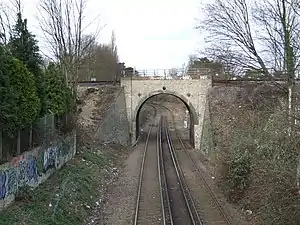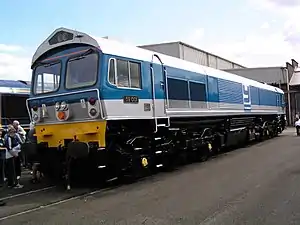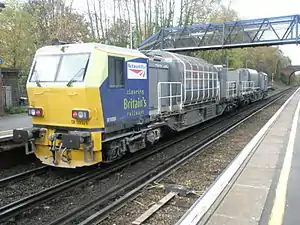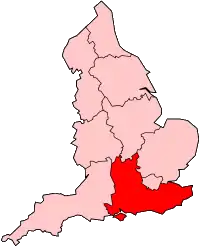Medway Valley line
The Medway Valley line is the name given to the railway line linking Strood and the Medway Towns with Maidstone West and onward to Paddock Wood & Tonbridge. High Speed services also link between Maidstone West, Aylesford, Strood and London St Pancras International (peak only). The section from Maidstone West to Tonbridge passes through some of Kent's most picturesque countryside along the narrower sections of the River Medway.
| Medway Valley line | |||
|---|---|---|---|
 The line being crossed by the Maidstone East line near Maidstone Barracks. There is no connection between them. | |||
| Overview | |||
| Status | Operational | ||
| Owner | Network Rail | ||
| Locale | Kent South East England | ||
| Termini | Strood Paddock Wood | ||
| Stations | 13 | ||
| Service | |||
| Type | Suburban rail, Heavy rail | ||
| System | National Rail | ||
| Route number | 01 | ||
| Operator(s) | Southeastern | ||
| Rolling stock | Class 375 "Electrostar" Class 395 "Javelin" Class 465 "Networker" Class 466 "Networker" | ||
| History | |||
| Opened | 1856 | ||
| Technical | |||
| Line length | 21 miles 19 chains (34.18 km) | ||
| Number of tracks | 2 | ||
| Track gauge | 1,435 mm (4 ft 8 1⁄2 in) standard gauge | ||
| Electrification | Third rail, 750 V DC | ||
| Operating speed | 70 mph (110 km/h) | ||
| |||
Medway Valley line | ||||||||||||||||||||||||||||||||||||||||||||||||||||||||||||||||||||||||||||||||||||||||||||||||||||||||||||||||||||||||||||||||||||||||||||||||||||||||||||||||||||||||||||||||||||||||||||||||||||||||||||||||||||||||||||||||||||||||||||||||||||||||||||||||||||||||||||||||||||||||||||||||||||||||||||||||||||||||||||||||||||||
|---|---|---|---|---|---|---|---|---|---|---|---|---|---|---|---|---|---|---|---|---|---|---|---|---|---|---|---|---|---|---|---|---|---|---|---|---|---|---|---|---|---|---|---|---|---|---|---|---|---|---|---|---|---|---|---|---|---|---|---|---|---|---|---|---|---|---|---|---|---|---|---|---|---|---|---|---|---|---|---|---|---|---|---|---|---|---|---|---|---|---|---|---|---|---|---|---|---|---|---|---|---|---|---|---|---|---|---|---|---|---|---|---|---|---|---|---|---|---|---|---|---|---|---|---|---|---|---|---|---|---|---|---|---|---|---|---|---|---|---|---|---|---|---|---|---|---|---|---|---|---|---|---|---|---|---|---|---|---|---|---|---|---|---|---|---|---|---|---|---|---|---|---|---|---|---|---|---|---|---|---|---|---|---|---|---|---|---|---|---|---|---|---|---|---|---|---|---|---|---|---|---|---|---|---|---|---|---|---|---|---|---|---|---|---|---|---|---|---|---|---|---|---|---|---|---|---|---|---|---|---|---|---|---|---|---|---|---|---|---|---|---|---|---|---|---|---|---|---|---|---|---|---|---|---|---|---|---|---|---|---|---|---|---|---|---|---|---|---|---|---|---|---|---|---|---|---|---|---|---|---|---|---|---|---|---|---|---|---|---|---|---|---|---|---|---|---|---|---|---|---|---|---|---|---|---|---|---|---|---|---|---|---|---|---|---|---|---|---|---|---|---|---|---|---|---|---|
| ||||||||||||||||||||||||||||||||||||||||||||||||||||||||||||||||||||||||||||||||||||||||||||||||||||||||||||||||||||||||||||||||||||||||||||||||||||||||||||||||||||||||||||||||||||||||||||||||||||||||||||||||||||||||||||||||||||||||||||||||||||||||||||||||||||||||||||||||||||||||||||||||||||||||||||||||||||||||||||||||||||||
History
The line was built in two stages by the South Eastern Railway (SER). The first stage opened on 24 September 1844[1] and was a branch off the SER's first main line that crossed Kent between the coast ports of Dover and Folkestone and the LBSCR's main line at Redhill. According to a contemporary report in The Times newspaper, the opening of the branch line was an attempt to convey hops and fruit traffic back to Maidstone, which was losing trade to various points along the Dover line.[1] The junction was at Paddock Wood and followed the Medway Valley down to the county town of Maidstone that had been by-passed by the new main line. Twelve years later, on 18 June 1856 the extension of the line further down the Medway Valley was opened, to join the North Kent Line at Strood (which had opened in 1847). The extension was built by the railway contractor Edward Betts, who lived locally at Preston Hall and through whose estate the line partially passed. Betts arranged for his local station at Aylesford to be built in a much grander style than the other country stations along the line.
The SER started joint working with local rival London, Chatham and Dover Railway (LCDR) on 1 January 1899 under the name the South Eastern and Chatham Railway (SECR).[2] Post World War One, the railways were "grouped" and the SECR became part of Southern Railway.
For a brief period in the 1990s some services were extended to Gillingham (Kent) via Rochester and Chatham. This involved reversing trains and switching tracks at Strood.
It was designated by the Department for Transport as a community rail service in September 2007.[3]
Industry
The line served many rail connected industries, Aveling and Porter just south of Strood, cement works in the Cuxton, Halling and Snodland areas, a newsprint at New Hythe, Lafarge between Aylesford and Maidstone Barracks, Lockmeadow sidings at Maidstone West, Tovil goods depot and sand pits at Beltring
Infrastructure
Track
The line is double track throughout, apart from a short single-track section on approach to Paddock Wood station, with a maximum speed of 70 miles per hour (110 km/h). Between Paddock Wood and Tonbridge the maximum speed is 100 miles per hour (160 km/h).
Stations
The line serves the following stations: Strood, Cuxton, Halling, Snodland, New Hythe, Aylesford, Maidstone Barracks, Maidstone West, East Farleigh, Wateringbury, Yalding, Beltring, Paddock Wood and Tonbridge
Signalling
During 2005, the signalling systems were upgraded, replacing the traditional semaphore signals with coloured light signals. Further modifications have since been made with the expansion of the North Kent Signalling Centre. The level crossing at Yalding has the only signal on the Southeastern network to display a flashing white light as the proceed aspect.
Electrification
The line from Strood to Maidstone West was electrified (at 750 V DC third rail) by the Southern Railway, opening on 2 July 1939. The rest of the line from Paddock Wood to Maidstone West was electrified under Stage 2 of Kent Coast electrification by BR's 1955 Modernisation Plan, opening to traffic on 18 June 1962.
Train services
Services are operated by Southeastern.
Trains typically run a half-hourly service between Strood and Maidstone, with one train per hour carrying on through to Paddock Wood and Tonbridge. There is no longer an early morning service to London Bridge. Train's previously ran through to Tonbridge, but since 2020, now terminate at Paddock Wood, while the Maidstone West to Strood shuttle runs only during peak hours.
High Speed introduction
On 18 March 2011, Southeastern announced the start of a new high speed service from Maidstone to St Pancras International via Strood on a trial basis. During the morning rush hour, there are 3 trains from Maidstone West to St Pancras International, and 1 train heading in the opposite direction. In the evening rush hour, the service is reversed (3 trains to Maidstone West, and 1 train to St Pancras International).
A trial service commenced on 23 May 2011[4] and comes as a result of changes on the North Kent line to improve punctuality of existing services. This service has since been made permanent.
Traction and rolling stock
The main rolling stock used on the line is 3 car Class 375/3 Electrostars.[5]
Class 395 Javelins serve the line during Monday to Friday peak hours with high speed services from St. Pancras International to Maidstone West, with Snodland the only intermediate station it serves on the line.[6]
| Class | Image | Type | Cars per set | Top speed | Number | Operator | Notes | Built | |
|---|---|---|---|---|---|---|---|---|---|
| mph | km/h | ||||||||
| Class 395 Javelin |  |
EMU | 6 | 140 (HS1) 100 (Mainline) | 225 (HS1) 160 (Mainline) | 29 | Southeastern | Peak time high speed services between Maidstone West and St.Pancras International | 2007–2009 |
| Class 375 |  |
3 or 4 | 100 | 160 | 140 | Strood to Tonbridge services usually operated by 375/3s but 375/6/7/8/9s may occasionally appear. | 1999–2005 | ||
| Class 465 / 466 |  |
EMU | 4 (465)
2 (466) |
75 | 120 | 145 (465)
43 (466) |
Monday - Saturday Strood - Maidstone West services usually operated by single Class 466, although during leaf-fall season or during periods of potential icing on the conductor rail, a pair of 466's or a single Class 465 may be used for resiliance | 1992 | |
Freight/Other
A variety of freight and other services frequent the line, including , as well as through traffic from Hoo Junction and Tonbridge yard.
Aggregates traffic also features, with destinations including Allington and Aylesford aggregates sidings.
| Class | Image | Type |
|---|---|---|
| Class 59 |  |
Diesel Electric |
| Class 66 | .jpg.webp) |
Diesel Electric |
| Class 73 | _(geograph_4833956).jpg.webp) |
Electro-Diesel |
| MPV |  |
|
References
- "Opening Of The Maidstone Branch Railway". The Times Digital Archive. 25 September 1844. Retrieved 27 November 2014.
- Awdry, Christopher (1990). Encyclopaedia of British railway companies. Wellingborough: Stephens. ISBN 1-85260-049-7. OCLC 19514063.
- "North West Rail passengers set for bigger say". GOV.UK. 18 January 2012. Retrieved 14 June 2020.
- http://www.kentonline.co.uk/kent_business/home/2011/may/23/maidstone_high_speed.aspx
- Cheeseman, Clive (18 June 2009). "NETWORK RAIL - KENT ROUTE UTILISATION STRATEGY - DRAFT FOR CONSULTATION (SUMMARY)". Maidstone Borough Council. Retrieved 15 June 2020.
- "Medway Valley Line". Kent Community Rail Partnership. Retrieved 15 June 2020.
Further reading
External links
| Wikimedia Commons has media related to Medway Valley Line. |
- http://www.kentrail.org.uk/medway_valley_line.htm – Map of the Medway Valley line (Strood to Paddock Wood)
- https://web.archive.org/web/20081112101428/http://www.ordnancesurvey.co.uk/oswebsite/ – Ordnance Survey website

